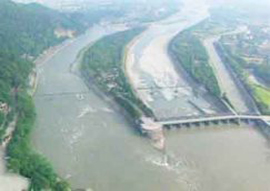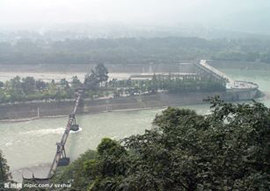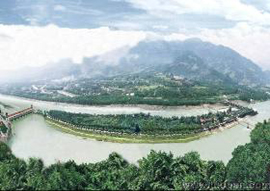Dujiangyan is an irrigation infra-structure built in 256 BC by the Kingdom of Qin. It is located in the Min River in Sichuan Province of China, near the capital Chengdu. It is still in use today and still irrigates over 5,300 square kilometers of land in the region. River in Sichuan Province of China, near the capital Chengdu. It is still in use today and still irrigates over 5,300 square kilometers of land in the region.
History
Planning
During the Warring States period, around 2,300 years ago, the people who lived along the banks of the Min River were plagued by annual flooding. Qin governor Li Bing investigated the problem and discovered that the river was swelled by the fast flowing spring melt-water from the local mountains that burst the banks when it reached the slow moving and heavily silted stretch below.
The most obvious solution would have been to build a dam but Li Bing had also been charged with keeping the waterway open for military vessels to supply troops on the frontier, so instead he proposed to construct an artificial levee to redirect a portion of the river’s flow and then to cut a channel through Mount Yulei to discharge the excess water upon the dry Chengdu Plain beyond.
Construction
Li Bing received 100,000 taels of silver for the project from King Zhao of Qin and set to work with a  team said to number tens of thousands. The levee was constructed from long sausage-shaped basket of woven bamboo filled with stones known as Zhulong held in place by wooden tripods known as Macha. The massive construction took four years to complete. team said to number tens of thousands. The levee was constructed from long sausage-shaped basket of woven bamboo filled with stones known as Zhulong held in place by wooden tripods known as Macha. The massive construction took four years to complete.
Cutting the channel proved to be a far greater problem as the tools available to him at the time, prior to the invention of gunpowder, were unable to penetrate the hard rock of the mountain so he used a combination of fire and water to heat and cool the rock until they cracked and could be removed. After eight years of work a 20 m wide channel had been gouged through the mountain.
Legacy
After the system was finished, no more floods occurred. The irrigation made Sichuan the most productive agricultural place in China. Li Bing was loved so much that he became a god to the people there. On the east side of Dujiangyan, people built a shrine in remembrance of Li Bing.
Li Bing’s construction is also credited with giving the people of the region a laid-back attitude to life, by eliminating disaster and insuring a regular and bountiful harvest it has left them with plenty of free-time.
Today, Dujiangyan has become a major tourist attraction. It is also the admiration of scientists around the world, because it has one ingenious feature. Unlike contemporary dams where the water is blocked with a huge wall, Dujiangyan still lets water go through naturally. Modern dams do not let fish go through very well, since each dam is a wall and the water levels are different. In 2000, Dujiangyan became a UNESCO World Heritage Site.
2008 Sichuan earthquake
On May 12, 2008 a massive earthquake centered on the Dujiangyan area struck. Initial reports indicate that the Yuzui Levee was cracked but not severely damaged.
Engineering Constructions
Fish Mouth Levee
Irrigation Head
Li Bing's Irrigation System consists of three main constructions that work in harmony with one another to ensure against flooding and keep the fields well supplied with water.
Yuzui or Fish Mouth Levee, named for its conical head that is said to resemble the mouth of a fish, is the key part of Li Bing's construction. It is an artificial levee that divides the water into inner and outer streams. The inner stream carries approximately 40%, rising to 60% during flood, of the river's flow into the irrigation system whilst that outer stream drains away the rest, flushing out much of the silt and sediment.
Feishayan or Flying Sand Weir has a 200 m-wide opening that connects the inner and outer streams. This ensures against flooding by allowing the natural swirling flow of the water to drain out excess water from the inner to the outer stream. A modern reinforced concrete weir has replaced Li Bing's original weighted bamboo baskets.
Baopingkou or Bottle-Neck Channel, which Li Bing gouged through the mountain, is the final part of the system. The channel distributes the water to the farmlands to the west, whilst the narrow entrance, which gives it its name, works as a check gate, creating the whirlpool flow that carries away the excess water over Flying Sand Fence, to ensure against flooding.
Anlan Suspension Bridge
Anlan or Couple's Bridge spans the full width of the river connecting the artificial island to both banks and is known as one of the Five Ancient Bridges of China. Li Bing's original Zhupu Bridge only spanned the inner stream connecting the levee to the foot of Mount Yulei. This was replaced in the Song Dynasty by Pingshi Bridge which burned down during the wars that marked the end of the Ming Dynasty.
In 1803 during the Qing Dynasty a local man named He Xiande and his wife proposed the construction of a replacement, made of wooden plates and bamboo handrails, to span both streams and this was this was nick-named Couple's Bridge in their honor. This was replaced in 1970 by a modern bridge of reinforced concrete and steel chains that is now opened to visitors. |
